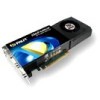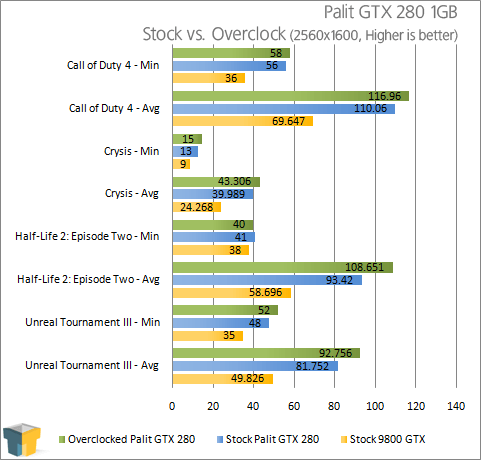- Qualcomm Launches Snapdragon 4 Gen 2 Mobile Platform
- AMD Launches Ryzen PRO 7000 Series Mobile & Desktop Platform
- Intel Launches Sleek Single-Slot Arc Pro A60 Workstation Graphics Card
- NVIDIA Announces Latest Ada Lovelace Additions: GeForce RTX 4060 Ti & RTX 4060
- Maxon Redshift With AMD Radeon GPU Rendering Support Now Available
Palit GeForce GTX 280 1GB

With so many options on the market right now, what makes the GTX 280 a good choice for anyone? The fact that it is the highest-performing card out there sure helps, but it’s still not for everyone. To join this club, you better hope you have one massive resolution to push.
Page 12 – Overclocking, Pushing our Games to the Limit
Defining a “Stable Overclock”
If you’ve read any of my processor reviews, you are probably aware that I don’t much care for an unstable overclock. As far as I am concerned, a high overclock is only good if it’s stable, because realistically, no one purchases a new GPU for the sake of only finding the maximum overclock. That is why I focus on finding the max stable overclock, rather than an overclock that can barely pass a benchmark run.
To find a max stable overclock, I first find an overclock that I believe could be stable. Once I do that, I’ll run a single loop of 3DMark 2006 to test for stability and to look for artifacts. If that run passes successfully, I’ll jump into a game quickly to see if the same results are exhibited in real-world gameplay. If that proves successful, I then run a loop of 3DMark 2006 for 4 – 8 hours at 2560×1600 2xAA to stress the card to its limit.
If after that point, the card is deemed stable (as in, no crashes occurred and there are still no artifacts), then I will proceed with benchmarking four select titles again: Call of Duty 4, Crysis, Half-Life 2: Episode Two and also Unreal Tournament III.
All overclocked testing occurs at 2560×1600 for the simple fact that it’s such a strenuous resolution. For comparisons sake, I also include results from a card that’s a step up from our overclocked model.
Palit GTX 280 1GB
Does it even make sense to overclock such a massive GPU? Of course it does, are you nuts? With the performance so high to begin with, I was unsure how much further it could be pushed, but I was left impressed. While stock speeds are 602MHz Core, 1,296MHz Shader and 1,107MHz Memory, our stable maximum overclock was 700MHz Core, 1400MHz Shader and 1,275MHz Memory.
It might seem a bit odd that our max overclocks were such even numbers, but I found it to be the case. Even at 710MHz, instabilities arose, and so I consider 700MHz to be a safe bet. Likewise for the Shader clocks. Overall though, impressive boosts to the clocks all-around. But what real-world boost can be seen?

Compared to the 9800 GTX, there’s no comparison. That in a way is upsetting, because just two months ago, I thoroughly enjoyed the performance from it. Tis how technology goes, though. Overall, the increases seen are negligible considering how fast the card is to begin with, but any boost is nice. Might as well push the PC to the limit, right?
Pushing Our Games to the Limit
Some of our tests don’t do the GTX 280 justice, because we share the same settings between all of the mid-range to high-end cards we test. After the basic testing was completed, I revisited all eight of our games to see just how much further the in-game settings could be pushed before the card could no longer handle them. All testing was done at 2560×1600, which is currently the highest consumer resolution on the market, weighing in at 4.1 megapixels. By comparison, 1920×1200 is 2.3 megapixels. So it goes without saying, if you are running any resolution lower than 2560×1600, you will be laughing.
In the end, almost every-single game in our roundup could be maxed out and still run at an extremely playable FPS. Half-Life 2 was one example. With everything maxed, including 16xAA and 16xAF, the game ran like a freakin’ dream. It ran amazingly, and in all seriousness, there’s no way I could believe it could run any better, at least at a noticeable real-world level. Call of Duty 4 was another example. Even totally maxed out, it ran swimmingly.
With Crysis, the game played well with everything maxed, however I did decrease Texture and Object Quality to Medium, as it did become too much for the GPU after a while. This is one of the few games where a second GTX 280 would actually come in handy. For those who want the absolute most from this game, there is really only one option.
In the end, the only other game to not run perfectly maxed out was Call of Juarez. The furthest it could be pushed was 4xAA, along with our chosen options as seen on the methodology page. Anything higher for Anti-Aliasing and the game begins to slow down fast. Again, this might be another example where a second GPU would do well, but I’m doubting many people like this game that much.
Support our efforts! With ad revenue at an all-time low for written websites, we're relying more than ever on reader support to help us continue putting so much effort into this type of content. You can support us by becoming a Patron, or by using our Amazon shopping affiliate links listed through our articles. Thanks for your support!





